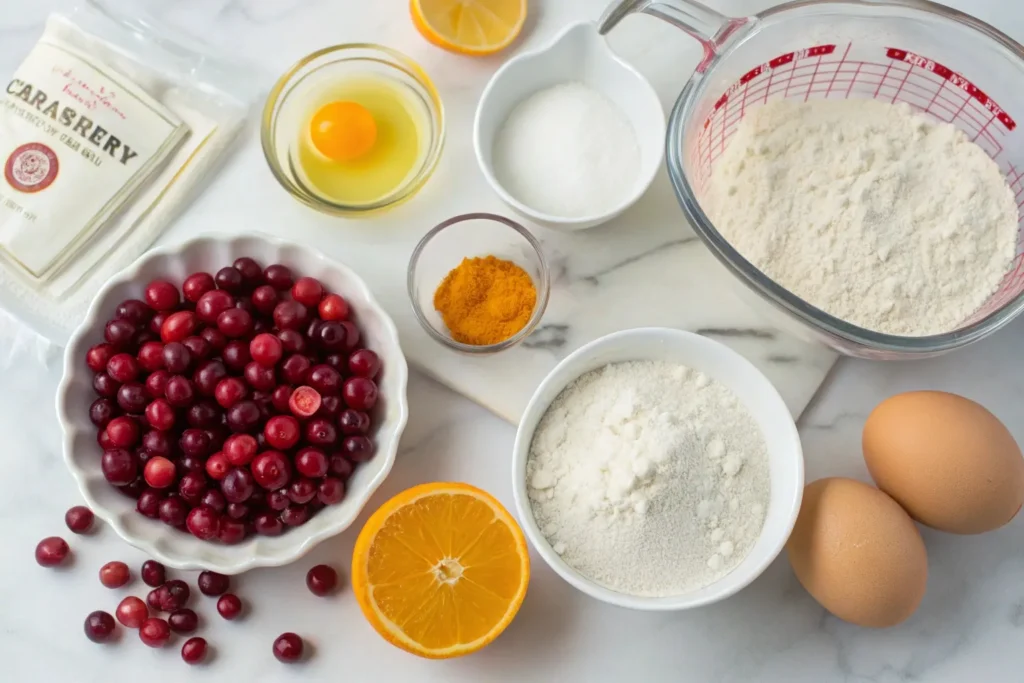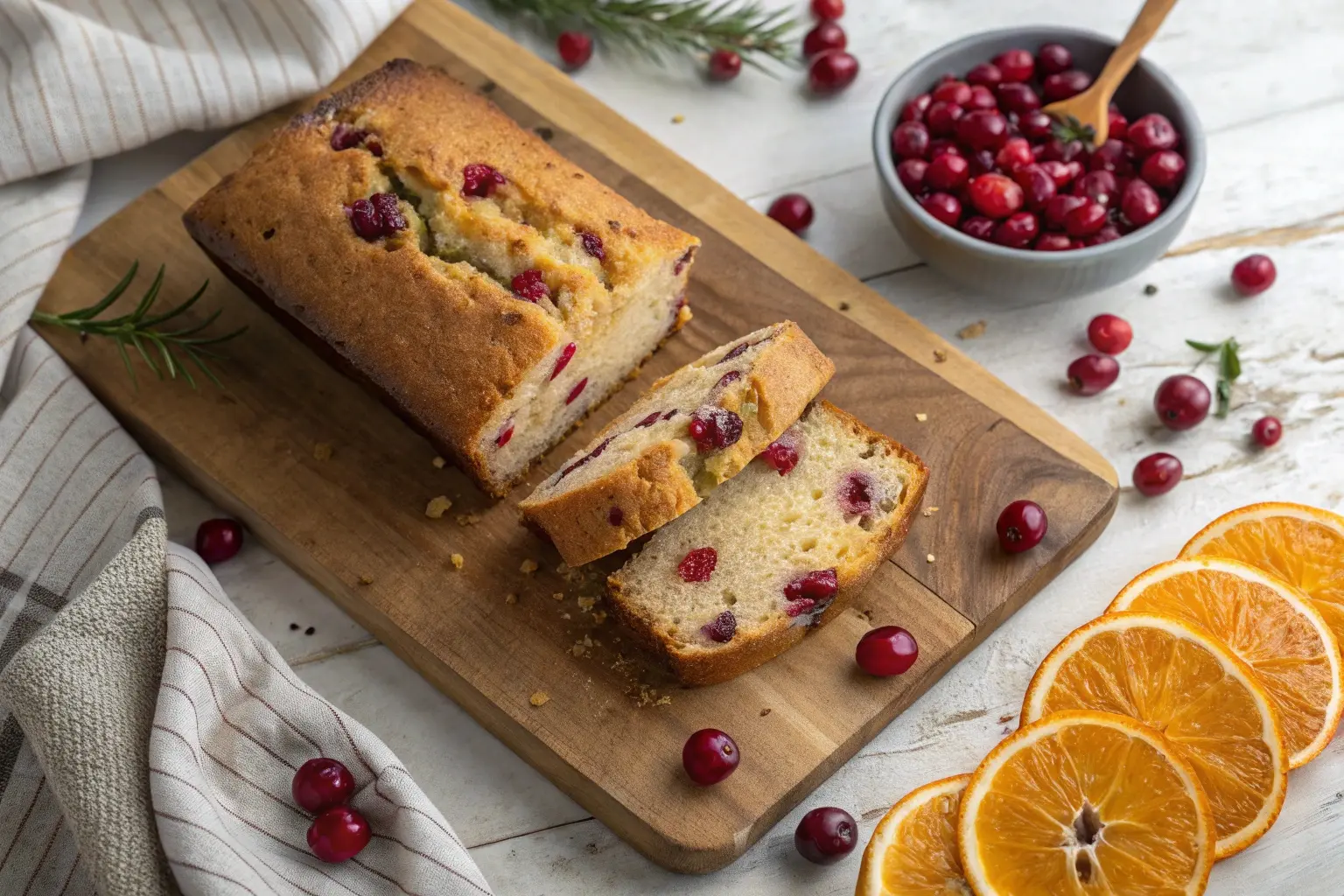Cranberry bread is a delightful treat, but it can be frustrating when your loaf crumbles apart instead of slicing cleanly. If you’ve ever asked yourself, “Why does my cranberry bread fall apart?”, you’re not alone! Quick breads like cranberry bread are prone to structural issues, but understanding the causes can help you avoid them. In this article, we’ll explore common reasons for crumbling bread and provide tips to ensure a perfectly moist and cohesive loaf every time. Let’s dive into the secrets behind sturdy, sliceable cranberry bread.
Table of Contents
Understanding the Structure of Cranberry Bread
The Role of Ingredients in Bread Structure
The ingredients you choose play a critical role in determining whether your cranberry bread holds together or falls apart. Flour, for example, is the foundation of your bread’s structure. It contains gluten, which acts like a glue, holding everything in place. However, not all flours are created equal. Using whole-grain flour or gluten-free substitutes can weaken the bread’s ability to stay intact if not balanced correctly with other ingredients.
Similarly, eggs and fats like butter or oil bind the ingredients together. Eggs add richness and structure, while fats keep the bread moist and tender. A lack of these ingredients, or using them in the wrong proportions, can lead to a crumbly loaf.
Why Quick Breads Are More Prone to Falling Apart
Unlike yeast breads, which rely on kneading and gluten development, quick breads like cranberry bread depend on chemical leaveners such as baking powder or baking soda. While these create a rise, they don’t provide the structural integrity gluten offers in yeast breads. This means quick breads are more susceptible to issues like crumbling.
Additionally, quick breads often include chunky ingredients, such as cranberries, nuts, or chocolate chips. While delicious, these add-ins can disrupt the dough’s cohesion if overused. The key is balancing these extras with enough batter to hold everything together.
Understanding these factors is the first step toward troubleshooting and perfecting your cranberry bread.
Common Reasons for Cranberry Bread Falling Apart
Overmixing the Batter
One of the most common answers to the question “Why does my cranberry bread fall apart?” is overmixing the batter. When you stir the ingredients too much, you develop excess gluten, which can lead to a dense texture and structural instability. Instead of holding together, the bread becomes tough on the outside and crumbly on the inside.
To avoid this, mix the wet and dry ingredients until they’re just combined. It’s okay if a few lumps remain—overmixing in pursuit of a perfectly smooth batter is a mistake. Also, use a spatula or spoon rather than an electric mixer to keep the batter light and airy.
Imbalanced Ratios of Wet to Dry Ingredients

Another frequent issue is an incorrect ratio of wet to dry ingredients. Too much liquid can weaken the bread’s structure, making it overly moist and prone to falling apart. On the flip side, too much flour can result in a dry, crumbly loaf.
For consistent results, measure your ingredients precisely. Use a kitchen scale for accuracy, especially when dealing with flour. Scooping directly from the bag can pack in too much, throwing off the delicate balance.
Too Many Add-Ins (Nuts, Fruits, etc.)
Adding cranberries, nuts, or chocolate chips is a highlight of baking cranberry bread, but too many extras can disrupt the bread’s structure. These chunky ingredients create weak spots in the batter, causing it to break apart more easily.
Stick to the recommended quantity of add-ins in your recipe. If you want to add more, increase the batter proportionally to maintain the right balance. Additionally, coat your add-ins in a light dusting of flour before folding them into the batter. This simple trick helps distribute them evenly and prevents them from sinking.
Incorrect Baking Temperature or Time
Temperature and timing are critical when baking. An oven that’s too hot can cause the bread to rise and crack unevenly, while one that’s too cool may leave the bread undercooked and fragile. Always preheat your oven and use an oven thermometer to ensure accurate baking temperatures.
Bake the bread until a toothpick inserted in the center comes out clean or with a few moist crumbs. Removing it too soon results in a wet, unstable loaf that’s prone to crumbling.
Troubleshooting Cranberry Bread Issues
How to Measure Ingredients Accurately
Precision is key when baking cranberry bread. Mismeasured ingredients can easily lead to the dreaded question: “Why does my cranberry bread fall apart?” For example, too much flour creates a dry batter, while excess liquid weakens the structure.
To avoid these issues:
- Use the Spoon-and-Level Method: For flour, spoon it into your measuring cup and level it with a knife. Don’t scoop directly from the bag, as this can pack the flour and result in too much.
- Measure Liquids at Eye Level: Use a liquid measuring cup, and always check the measurement from eye level to ensure accuracy.
- Weigh Ingredients When Possible: A kitchen scale provides the most consistent results, eliminating the guesswork.
Best Practices for Mixing Quick Bread Batter
The way you mix your batter has a direct impact on your bread’s texture and cohesion. Overmixing, as mentioned earlier, can lead to dense, crumbly bread. Instead:
- Combine Wet and Dry Ingredients Separately: Mix the wet ingredients in one bowl and the dry ingredients in another.
- Fold Gently: When combining the two, use a spatula to fold the batter just until the dry streaks disappear. Avoid vigorous stirring.
- Add-In Strategy: Incorporate cranberries, nuts, or other mix-ins at the very end to minimize additional mixing.
Choosing the Right Pan Size and Greasing Techniques
Your choice of pan and how you prepare it can also impact your bread’s structure. Using the wrong size pan might cause the bread to rise unevenly and crack. A standard 9×5-inch loaf pan works well for most cranberry bread recipes.
Greasing your pan properly prevents sticking, which can tear the loaf apart when you remove it. Options include:
- Greasing with Butter or Oil: Coat the pan evenly, paying special attention to the corners.
- Using Parchment Paper: Line the pan with parchment for easy removal, especially if your bread tends to stick.
By applying these troubleshooting techniques, you can ensure your cranberry bread stays moist, cohesive, and delicious.
Pro Tips for Preventing Crumbling Cranberry Bread
Cooling and Slicing Techniques
The way you cool and slice your cranberry bread can significantly affect its structure. Many bakers ask, “Why does my cranberry bread fall apart after slicing?” The answer often lies in impatience. Cutting the bread while it’s still warm may seem tempting, but it’s a common culprit for crumbling.
- Cool Completely: Allow the bread to cool in the pan for at least 10 minutes, then transfer it to a wire rack. Let it cool completely before slicing. This step allows the structure to set and prevents tearing.
- Use a Sharp Bread Knife: A serrated knife works best for clean, even slices. Dull blades can crush the bread, causing it to break apart.
- Slice Gently: Avoid putting too much pressure while slicing. Instead, use a sawing motion to cut through without damaging the loaf.
Using Fresh Ingredients for Better Texture
Fresh ingredients, particularly leavening agents like baking powder or baking soda, play a crucial role in the bread’s texture. Expired or old ingredients can result in uneven rising, leading to a weak structure. Similarly, fresh cranberries offer better moisture content and flavor compared to dried ones.
- Check Expiration Dates: Always ensure your leavening agents are within their expiration date for optimal performance.
- Choose Fresh Cranberries: These provide a better balance of moisture and structure compared to overly dried or frozen alternatives.
FAQs About Cranberry Bread Falling Apart
Can Overmixing Really Ruin My Cranberry Bread?
Yes, overmixing is a common reason for structural issues. When you mix the batter too much, you activate gluten, which can lead to a dense and crumbly loaf. To avoid this, mix just until the dry ingredients are incorporated into the wet ones. A few lumps in the batter are perfectly fine and won’t affect the final product.
What’s the Best Way to Add Nuts and Fruits Without Compromising Structure?
Chunky add-ins like nuts and cranberries can create weak spots in the bread if not incorporated properly. To prevent this:
- Toss your add-ins in a small amount of flour before folding them into the batter. This helps distribute them evenly and keeps them from sinking.
- Avoid overloading the batter with too many extras, as this can overwhelm the structure.
How Do I Know When My Cranberry Bread Is Fully Baked?
Underbaking can leave your bread too soft and unstable, making it more prone to falling apart. Use these tips to ensure your bread is fully baked:
- Perform the Toothpick Test: Insert a toothpick into the center of the loaf. If it comes out clean or with a few moist crumbs, your bread is done.
- Check for Firmness: Lightly press the top of the bread. It should feel firm and spring back slightly.
With these tips and troubleshooting techniques, your cranberry bread will stay intact and delicious every time.
Conclusion: Perfecting Your Cranberry Bread
Mastering the Balance of Flavors and Structure

Achieving the perfect cranberry bread requires a balance between flavor and structure. If you’ve been asking, “Why does my cranberry bread fall apart?”, the key lies in understanding the factors that impact its cohesion. From measuring ingredients accurately to ensuring proper mixing techniques, small adjustments can make a big difference in the final outcome.
Take your time to prepare the batter correctly, avoiding common pitfalls like overmixing or overloading with add-ins. Using fresh ingredients, including cranberries and leavening agents, helps maintain the bread’s moisture and structure. Additionally, cooling the bread completely before slicing ensures that it holds together beautifully.
Why Patience Is Key to Great Quick Bread
Patience plays a crucial role in baking. It’s tempting to cut into a warm loaf, but waiting for it to cool completely can save you from crumbling disappointment. Similarly, taking the time to test your bread for doneness ensures it’s fully baked and stable.
Ultimately, perfecting your cranberry bread is a combination of art and science. With practice, you’ll find that your loaves become more consistent, flavorful, and satisfying. So next time you wonder, “Why does my cranberry bread fall apart?”, revisit these tips and enjoy the rewarding experience of baking a flawless loaf.

